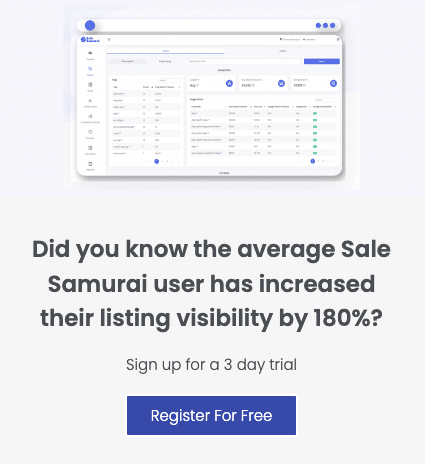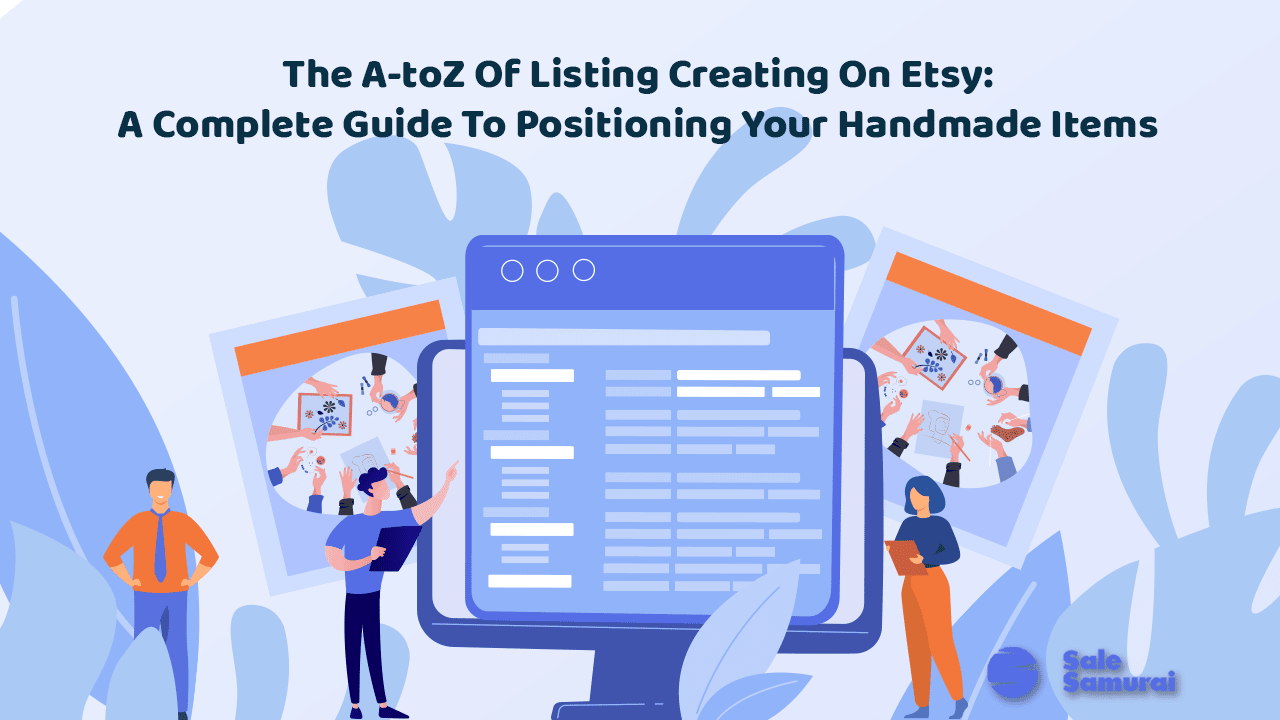
Handmade items represent the most popular product category on Etsy. They fit perfectly with the target audience of a marketplace well-known for its authentic, creative, and unique items. This category is absolutely crucial if you’re looking to expand your reach and add diversity to your portfolio.
However, if you want to enjoy guaranteed sales, you must follow a step-by-step approach to listing creation.
Below, we’ve prepared a practical guide to creating your listing and positioning your handmade items on Etsy.
Creating your handmade item listings on Etsy: Step-by-step
The process of building a listing on Etsy is not strictly limited to uploading a product to sell. It consists of research and product design as the initial steps.
Let’s look at a reliable step-by-step approach to listing creation from start to finish.
Step 1: Conduct thorough research

The starting point of listing creation should always be research. This phase can be divided into several equally important components.
Discover a profitable niche
The discovery of an appropriate niche to target is key to your success on Etsy. In regards to handmade items, there are a multitude of niches to explore, like handmade accessories, handmade clothing, handmade furniture, and more.
Throughout your search for a rewarding niche, look for markets that are large enough in terms of customer demand, yet not very competitive. These characteristics increase the chances of profitability for new entrants.
Search for fruitful keywords
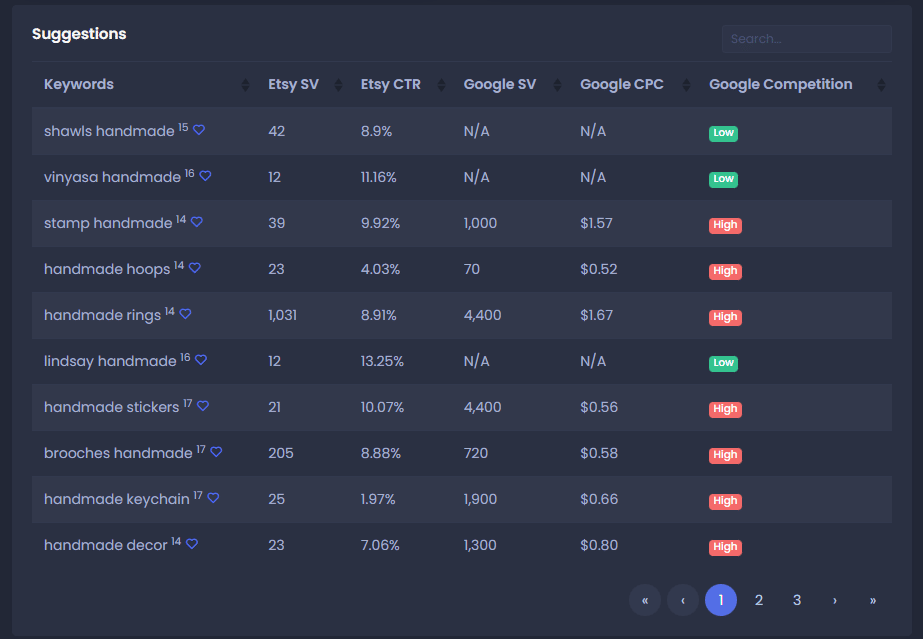
Next, you’ll need keywords in your listings to make your handmade items discoverable. Keywords help you rank better on Etsy search results and are a vital element of your performance.
Keyword research can also help you identify underserved niches that attract a lot of search volume. The insights extracted throughout the process can also be useful when shaping your product and defining your target audience.
Ideally, it’s best to choose keywords that receive a high search volume, yet are classified as low-competition. These are the ones that will be easiest to rank for. In other words, finding such keywords doubles your chances of quick and consistent sales on Etsy.
Examine how attractive the niche is for shoppers
We briefly touched upon search volume in the previous sections. However, it deserves its own dedicated space in this article, as it’s equally important as all of the other parts of your research.
Search volume reveals how attractive certain products are for buyers. It’s a metric you can discover when researching a specific keyword or performing overall keyword research. The higher the search volume for a word or phrase, the more users are interested in the related products and are likely to buy.

Analyze pricing strategies of other sellers
Once you’ve established a niche and performed the previous activities, it’s time to peek into the pricing tactics used by competitors in the market. Knowing how others are pricing their listings will give you an overview of the minimum, maximum, and average prices you can set.
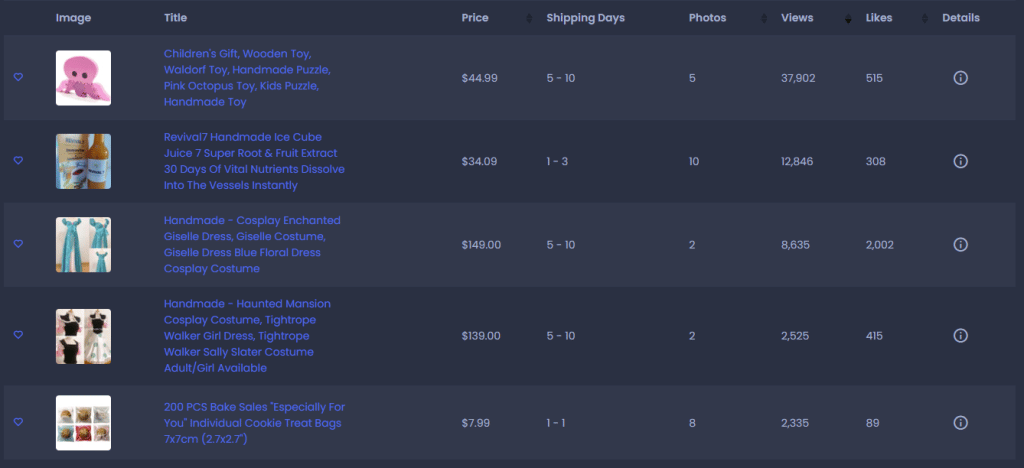
Although there are no official pricing restrictions, underpricing or overpricing inevitably hurts your listings. It makes them less attractive and not as competitive. In other words, choosing the most appropriate pricing range is critical for how well your listings sell on Etsy.
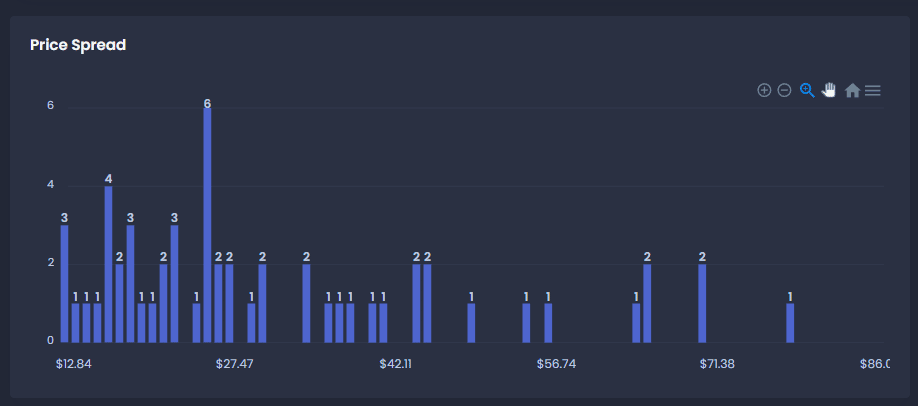
Explore optimization techniques employed by the competition
Finally, research how other sellers in the niche are optimizing their listings to generate interest and improve rankings. Some components to look out for include title length and structure, descriptions, use of keywords, imagery, and others.
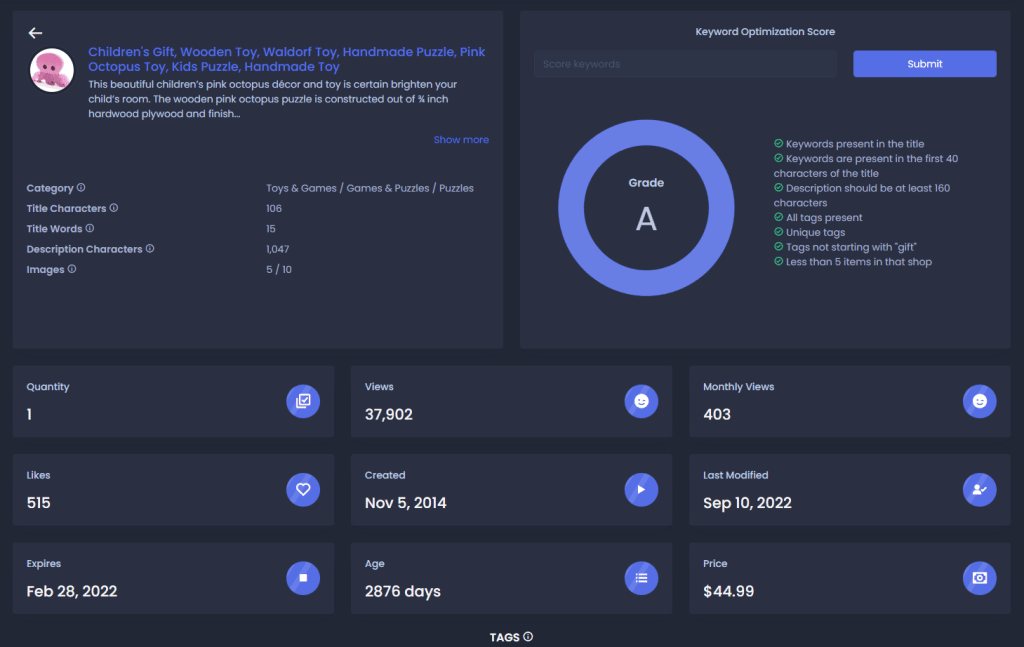
Understanding the optimization methods of your peers will enable you to adapt similar techniques to your own products.
Step 2: Create your product
After completing the research phase, you can move on to the creative part of the process – bringing your product to life.
Design and create your handmade item
Use the research phase of the process for ideas and inspiration for your products.
For instance, you may have discovered that keywords like “handmade flower jewelry” are prevalent on Etsy. It is therefore advisable to design jewelry with colorful flowers to be able to create listings that will satisfy this specific demand. In short, you must think about your target audience and tailor the product based on their expectations.
Step 3: Construct a listing
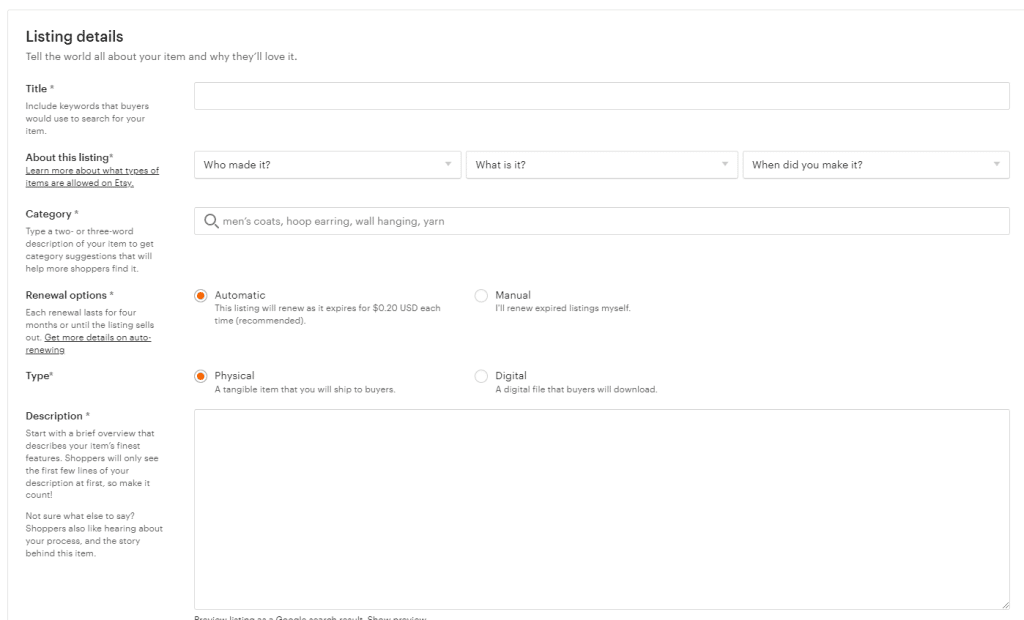
We’ve now reached the final step of positioning your handmade item on Etsy – the actual listing creation.
Here’s a quick guide.
Title
Start by adding a product title that best defines your handmade item. Make sure to stick to Etsy’s policies on title length and keep the text under 140 characters.
The title should be a combination of attractive and keyword-optimized text. In other words, it should sound catchy and exciting but also include essential keywords or tags that will make your listing visible to shoppers.
Description
The same rules apply to the creation of your product description.
Etsy enables sellers to create descriptions longer than 160 characters. Use this space to outline what your product is, what it aims to achieve, what products it’s made from, how large it is, or any other helpful information.
Keep in mind that it’s best to position essential keywords in the first 40 characters of the description for SEO purposes. Where possible, use bullet points to make the content easy to read and interesting for users.
Images
Next, make your listings stand out with professional and eye-grabbing images of your product. Etsy allows sellers to upload up to 10 images for each product.
The best practice is to use all of the 10 image options. This will improve the listing’s rankings and will get the product in front of more buyers.
Optimize with tags
Finally, take advantage of the 13 tags that Etsy grants to sellers for each created item.
These tags will further optimize the listing for rankings and help shoppers searching for similar products land on your handmade masterpiece.
Using Sale Samurai throughout your journey
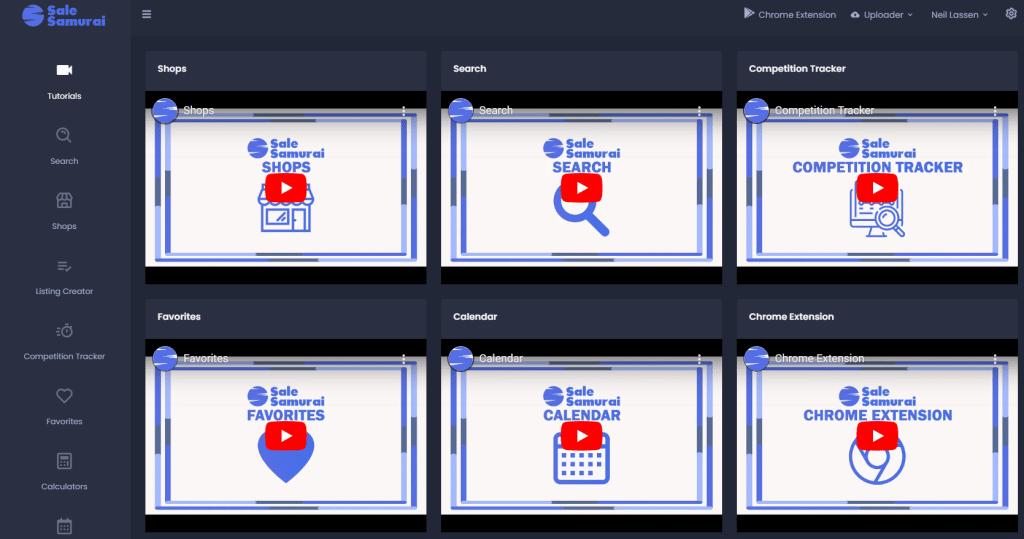
So far, so good. But how do you make all of the above happen?
The answer is simple. All you have to do is use Sale Samurai. Here’s how to utilize the business intelligence tool for every step in the guide above.
Researching with Sale Samurai
Once you’ve created a subscription for Sale Samurai, log into your account and go through the different research phases using the tool’s modules and features.
Niche & keyword discovery
The discovery of a profitable niche can be combined with keyword research. Why? Because analyzing different keywords and keyword suggestions often results in discovering interesting niches to tap into.
Start by performing a basic search using the Search module. Type in a main keyword that you would like to receive more information on and use as a stepping stone. For instance, in the case of handmade items, this could be simply “handmade”. On the screen, you’ll see a list of suggestions for similar keywords. You’ll receive data on two key elements for each one: their monthly search volume and competition level.

This information is vital for determining how large a niche is, how attractive it is for shoppers, and how easy it will be to outperform other sellers.
Before this list, the tool will display detailed insights about the particular keyword you’ve typed in. This includes the monthly search volume on Etsy, the click-through rate, and the competition on Etsy. In addition, there’s data from Google, which can also tell you how popular the keyword is in general.
Pricing & optimization techniques
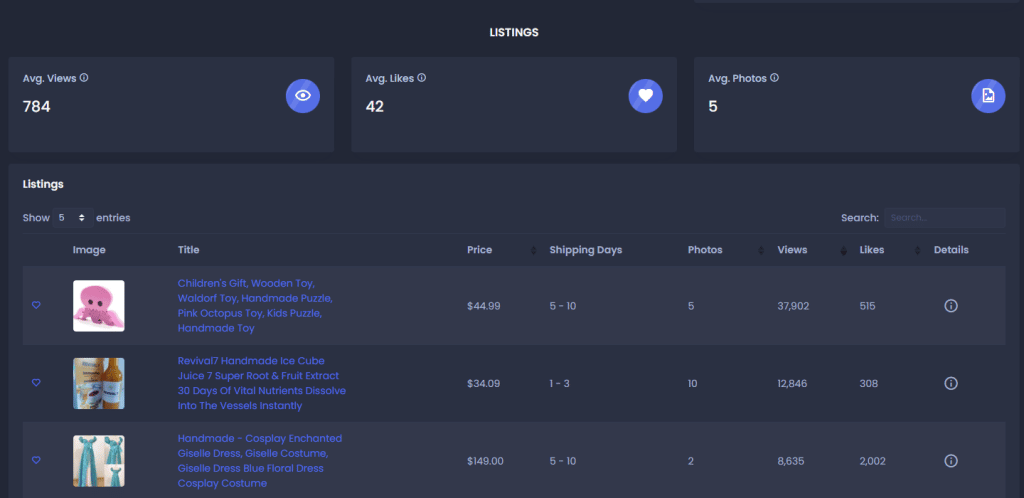
As you scroll down the screen, you’ll be shown additional information that is part of your overall research process. You can get an idea of the pricing strategy of other sellers via the minimum, maximum, and average prices section.

You can also observe how many images are used on average throughout the listings, which rank for the keyword. Not to mention that you have the option to observe in close detail separate listings that perform well and rank high for your chosen keyword.

Furthermore, you can use individual listings you’ve spotted on Etsy or seen as part of your Sale Samurai research. To do so, perform a single listing search using a specific URL. This will help you get a grasp on how other sellers optimize their products on the platform in terms of titles, descriptions, tags, and more.
Creating your listing with the Listing Creator tool
The next part of our guide was product creation. As the tool can’t be used for the physical composition of a product (apart from serving as an inspiration for design by showing what others are doing), we’ll move on to creating your listing. Sale Samurai features a Listing Creator tool. It enables sellers to create new listings and activate them on Etsy quickly. The software can save you substantial manual work and provide a more reliable and sophisticated listing creation process.

To use the module, you’ll need to connect your Etsy shop to your Sale Samurai account.
The results you can reap from following this guide
The steps outlined in this guide are recommended for both experienced and beginner sellers. Although there are numerous approaches to listing creation, we’ve extracted only the time-tested steps for success.
The way you proceed with the listing creation of your handmade items will inevitably dictate how successful your products will be on Etsy. If you want to minimize the risks and double your chances of more traffic and higher sales volumes, follow the steps we’ve shared with you in the suggested sequence.
This will enable you to create a bulletproof listing that will reward you with success and substantial earnings.
Don’t forget to use the support of high-quality business intelligence software like Sale Samurai. The tool can help you quickly access insights, putting you in an advantageous position over other sellers. And it goes for only $9.99 per month.





